In this article, we explain how Shopify print-on-demand works, from setting up a…
How To Start Print On Demand Business On Shopify
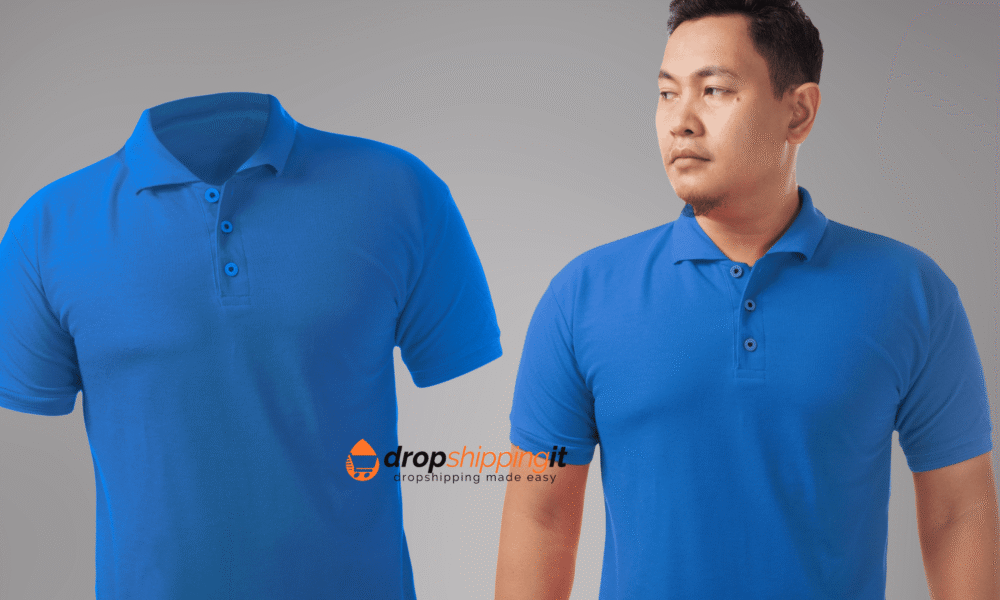
Whether you’re an artist, an entrepreneur, a writer, or a designer, physical products can be the perfect canvas to monetize your creativity.
Welcome to A free Print On Demand Business guide to help you find products, design a store, launch, and make your first Print-on-demand sale.
From backpacks to books, t-shirts to posters, you can put your unique spin on everyday products and sell them online.
However, if you follow the traditional route of buying and holding your inventory, Somebody will leave you with a pile of unsellable products.
The print-on-demand business model offers an alternative way to bypass the time, investment, and risk associated with inventory management.
It allows you to switch from creating to selling custom products at a fraction of the cost.
Table of Contents
Start A Print On Demand Business
If you intend to make extra bucks selling custom merchandise using the technique, you are in the right place.

We are not talking about some virtual reality concepts here. Print-on-demand is a dropshipping business model that is exponentially becoming commercially viable.
Like other selling structures, print-on-demand has the considerable potential to generate a decent income for the end retailer.
For beginner store owners, print-on-demand is a compelling category in the eCommerce business model. It is simple to get started since you do not need inventory.
However, a significant portion of creativity is necessary to balance the equation.
And the following is why.
You want unique design concepts. The good news is that you do not have to create the designs as a merchant.
There are, out of the commonplace, print-on-demand businesses to help you do just that.
In this guide, we will look at some of the obvious ones.
To align your profit margins, consider a couple of the design options.
To lead you on, listing some of the viable niches in the market is practical.
Print-on-demand products, in the first occurrence, are typically blank products.
Marketplaces such as Alibaba and Amazon sell plain hoodies, mugs, t-shirts, and caps of standard quality.
An online retailer gets to source the products and custom-design the graphics. One ideal thing makes the print-on-demand method tread over the other model.
POD gives the seller the independence to customize their product. They can likewise work with customer designs.
In other words, there are no design limits. Custom merchandise has a winning clientele base.
When the client orders, the retailer promptly designs the Print, makes finished merchandise, and ships it to the shopper.
How the Print-On-Demand Model Works
It is about that time this guide delves into a practical perspective.
The Print on demand houses many businesses.
Say a writer, for example, can impeccably fit into this model and produce better profit markups than ever before.

One way of hacking is by selling demand books. The same goes for designers and artists.
It is not rare to see wall art and art prints listed on 3rd party sales channels.
How do professional banks work on the POD system? You ask
Similar to other dropshipping models, there are a few POD alternatives to suit your definitive niche.
You want to reach the peak by eventually standing out to achieve an unequaled target audience.
Clients need to have overwhelming confidence in the quality of your merchandise. Big print-on-demand brands employ this approach to retain chronic clients all year long.

Your material needs to be of top-notch quality. Otherwise, it will be difficult to meet your proceeds prospects.
As a rule of thumb, the foremost step to maintaining the value clients see in your merchandise is sourcing extraordinary-quality items from suppliers.
You want a blank product to print a custom design without markings.
It is prudent to seek clarification from the supplier while placing the order.
Print-On-Demand (POD) dropshipping.
Factoring in the current trends, the POD model appears to align entirely with the drop shipping performance. A deal takes effect upon a client placing an order.
As a result, the trade does not need to hold onto any inventory.
It practically means that you do not need to have huge portions of stock levels in your storeroom.

If you use the sales channels, it says Shopify, and you can try a few POD merchandise.
The objective is to find one that has the potential to generate huge profits.
Besides, with POD dropshipping, you leave every requirement task in the hands of the supplier.
It includes printing the custom design and shipping the finished items to the end-user.
This means that the vendor can ease the order fulfillment procedure.
To be confident, you can try the print-on-demand services to discover unexploited business opportunities in a specific niche.
Close linking helps you earn some extra bucks from a pre-built shopper audience.
Consider your influence on social media. Instagram, for example, can be a real-world medium for creating shoppable posts for your POD merchandise.
You consider the need to carve a great niche; as a retailer, you can create visibility for your brand using the most traditional print-on-demand ideas.
This, in turn, sets you apart from your competition, which longs for an equal market audience.
Mainstream Print-On-Demand Product Ideas
T-shirts
Using the print-on-demand system, you can try several ideas. Plain T-shirts are a picturesque product sellers can use to sell their custom brands.
Most suppliers sell various T-shirt designs in bulk and at an exceedingly low price (e.g., round-neck, polo, and v-neck t-shirts).

The deal with T-shirts is that they are high-selling and easily flexible to numerous print-on-demand services. IBM owners, for instance, may find it easy to customize the companies’ brands on T-shirts.
Backpacks
It is one niche that is not so highly flooded and, at the same time, has a high conversion probability. Platforms like Pinterest, with an invasion of freshly updated designs, can be a great source of trendsetting fabric design prints.

To a high school teen or a college millennial, I trust that a custom-branded backpack feels like a must-have, and therefore, as a POD drop shipper, you want to work with the right demographics.
Also falling under this category are the Drawstring bags.
Often, the organization uses the bags as emblems to raise some theme awareness.
Hoodies
Selling custom-printed hoodies, which are closely akin to t-shirts, often goes far afield. As it is, the China market is aggressively investing in selling replica hoodies.

If you spot ‘Champion’ branded Hoodies on AliExpress retailing at sic ($30), chances are it is a replica. That said, so many income merchants are eking out on this front.
But on the contrary, it is vital to pay close attention to quality.
Merchants have a reliable alternative to selling POD services to online buyers by printing any design ordered.
Mug
Mugs are one of the most drenched niche categories on the POD model, yet they are highly lucrative.
Walk into any behemoth firm, and you will not miss spotting a mug branded with the company’s logo.

For most companies, it is more of a ritual that they have to let go. To achieve reasonable sales, you must be crafty and create a designed brand that extends beyond the bare bones.
Yoga Pants
Lessons on Yoga are not going anywhere; they are here to stay. What a fantastic way to monetize the POD business other than venturing into yoga pants.
The yoga pants are easy to blend with multiple print designs. Look at the yoga enthusiast; make no mistake, the market potential is quite noteworthy.
That indicates you can offer yoga pants as a POD service in your online store product category.
Phone Covers
Everyone owns a smartphone. A customized cover seems like a cheap yet powerful facelift idea. It gives your smartphone that glossy look and hides those embarrassing dents.
Besides your Print-on-demand business set goals over and above, a decent entrepreneurial spirit to hone some eccentric design skills goes a long way.
Towels
It is a grand plan to sell custom-printed towels to boost sales on your POD storefront. Does it sound pretty far-fetched? Right. I know.
But societies cuddle going to the beach. We do not doubt that, do we? It is an undeniable demand market to leverage as an online merchant.
eCommerce stores selling fancy branded towels gain tons of traffic from summer lovers and gym members.
Wall Stickers
How about becoming an interior deco guru? It sounds like a bold idea! Not so fast, buddy.
But here is the thing. At some point, people want to spruce up their personal living space by adding some extra accessories.
Folks’ craze might take you aback to lighten their living spaces.
As a potential hunter for this opportunity, what you want to have in check are close links to premium quality canvas suppliers.
Leggings
Be it a yoga lesson or that early morning jog, leggings are almost always a sound mood wave for women. They are sporty and convenient for such exercises.
To complement all that, some online merchants add a yoga mat, a ‘frequently bought together’ product; this tactic has some multi-fold perks.
Number one is expanding your print-on-demand base by introducing new merchandise to your catalogs.
And on the other hand, you are trying your purchaser’s impulsiveness to make more sales.
Neckties
Ideally, neckties are one niche product that blends in with trendy designs. Furthermore, like a watch or socks, neckties can be worn on any occasion, regardless of the day of the week.
Most of the 8-5 job, guys who sort to dress up and especially on that casual Friday mood-worry not, neckties have your back to pull that unique office look.
A Summary of Other POD Product Finding
- Throw pillows
- Pin-back buttons
- Fridge magnets
- Shower curtains
- Table clothes and blankets
Print On Demand Sites.
With the impactful progress of print-on-demand services, if you find the right tools, you can optimize your objectives as a retailer.
Which is the best solution to source service when selling branded merchandise to a client?
Well, to take this question to bed, this segment seeks to exhaust all the functionalities that each Print on demand site has,
So here is the final descriptive takeaway.
Printful
As it stands, Printful is setting the bar a notch higher if you consider all the Printiful features. Printful is mainly an eCommerce sales channel that tends to sell print-on-demand merchandise.
Fortunately, there are no minimum orders or sign-up fees. The Software program lets users sell their items or buy directly from Printiful.
To put it in not so many words, Printful affords you a front-row anytime you want to customize and drop ship any of the following merchandise:
- Hoodie and sweatshirts -Sports bras
- Backpacks -Sweatpants
- Coffee mugs -Phone case
- Stickers -Swimwear
- Engrave wristbands -Tote bags
- Jackets -Beach Towels
- Leggings
There is plenty to order from Printiful.
The Workings of Printiful Print-On-Demand Service
Similar to other POD solutions, first connect your online store to Printiful. The majority of its users are Shopify store owners.
Printful syncs quite impeccably with other bigwig sales channels like:
- Magneto
- Squarespace
- Bigcommerce
- 3dcart
- Ecwid
- Weebly
- Woocommerce
- Shipstation
Equally, merchants can ply with massive marketplaces like Inktale, Amazon, Etsy, Wish, and eBay.
By assimilating the store with Printiful, you can practically upload merchandise with your designs.
The software automates the order fulfillment requirement and simplifies logistics concisely.
It is possible to send all orders directly from your supplier to Printiful’s storeroom in a practical context.
Printiful stuff then prints all orders, packs, and ships to the rightful clients.
As part of order fulfillment, the Printiful team notifies the vendor and attaches a tracking number for each shipment.
In the end!
Your customer gets the product packaged in your brand, and fleetingly, it appears you shipped it yourself.
Printiful’s Foremost Features
Besides order fulfillment and warehousing, Printiful offers many other benefits, including integrating your Print-on-demand dropshipping business.
In any case, it still exceeds the bare minimum; in the meantime, it currently has four centrally positioned warehouses.
Printful has camp bases in Mexico, Latvia, North Carolina, and California, which makes it easy for clients to reach out.
That POD works with global carrier companies lessens shipping costs.
Printiful- a POD-oriented platform with various print customization options; this wide-reaching number stabilizes the success rate of deliveries.
Because Printiful syncs seamlessly with your store, you can automate the order import process with a button click.
The principal’s mobile friendliness is absolute, and Printiful is a cloud-based software accessible via an app on both Android and iOS devices.
Long story short, its ease of use is incomparable to a similar platform. From the dashboard, a vendor can design, sell, and view the status of each merchandise order.
Printify
There is absolutely no doubt that Printify is somewhat confusingly similar to Printiful. And guys, the similarity we discuss here is not just limited to the prefix.
Furthermore, it is a high-ranking solution whose features resemble those of Printiful.

Printify is free to use and has an assimilated network of print design suppliers. With close to 300 pieces of unique merchandise to list in your store.POD is an option for many POD merchants/
Workings Of Printify Print-On-Demand Service.
Wholly Printify functions effectively in the same style as Printiful. The users get to choose a product from its POD-focused litany.
If you have a specific logo or brand in mind, Printify’s design options will materialize all your likely clients’ demands.
The basic fact is that this solution integrates with Shopify, thereby garnering some significant credibility in the action-packed market.
Similar to matchups, Printify also links influential eCommerce website builders and leading marketplaces,
PrestaShop, Wix, and WooCommerce are big on their integrations list. It hints to vendors that they can list merchandise on their store, and using Printify gets you ahead of the curve regarding the order fulfillment process.
The Printify API section lets you make various adjustments to upraise your eCommerce business.
So what are the plans like?
Every vendor, while searching for the most gainful solution pricing, is something that never misses on their bucket list.
Apart from the free package that allows only five stores per account, Printify has a premium version.
Printify’s premium plan for only sic ($29) per month lets users scale up-connecting up to 10 various stores on one account.
As a merchant, you can customize the order import process and give a 20% discount on each product.
On the other hand, the Enterprise plan offers the most perks. This plan allows you to add unlimited online stores.
All a seller needs to do is make an official inquiry to get the Enterprise plan custom quote.
Printify’s premium regularly allows merchants unmediated access to updates and newly launched features.
You have access to API integration but must acquire the Enterprise package to continue working with it.
Printify plans’ versatility gives access to a dedicated account management team.
Lulu Xpress
If you are in the vending of books, then your go-to is Lulu Xpress. It distinctively sets itself apart from the rest.
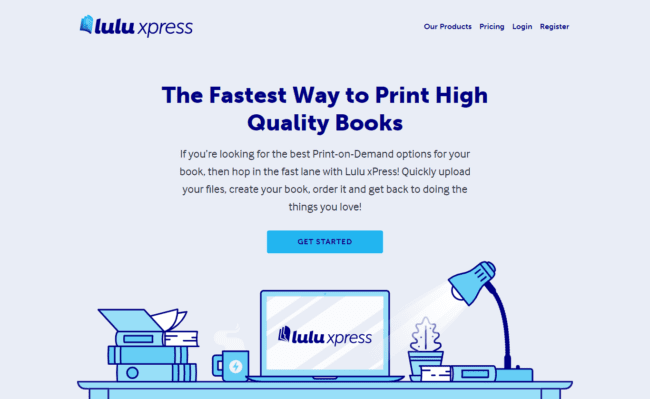
Lulu Xpress deliberately fashioned out to let merchants boost turnovers in their respective bookselling businesses.
On Lulu, xPress offers various Print-on-demand options, making it flexible even when designing and printing books.
Workings of Lulu Xpress
You must upload a file with the content printed on your ordered books. The following salient step is to select a well-connected book format. Lulu has many format and layout options.
With over sic (3000) formats, they range from A4 sizes to pocketbooks, executive designs, and digest guides. Once you have decided on the format, select the binding option.
The binding option is strictly subject to the size of the book.
The color options are worthwhile when fulfilling a book order. Lulu has a hands-on glance at your Print-on-demand needs, which is quite marvelous.
The following are the color variants that Lulu has in store:
- Standard black & white. They are widely used on dull and comprehensive content. That is a book with little to no graphical illustration and images.
- Standard text- the style suits a book with weighty content and a couple of pictures on top. It is impeccable for use in mid-range ink-density illustrations.
- They are often used because a merchant saves a few bucks on printing expenses.
- Premium black and white is an elite version of the standard option, and it is also practical. Its massive ink density makes it ideal for books heavy on images and graphical illustrations.
- Premium color is best suited for books with heavy content on pictures and light on text.
Besides, there is a wide range of paper sizes to pick from. On Lulu, order fulfillment is a straightforward process.
The team ships orders to more than 150 countries globally.
It may take anywhere between 3-5 business days to customize a print book in its entirety.
With an online calculator that auto-generates a custom quote for each print order, Lulu makes pricing inquiries easy.
Working with on-target figures, you want to select a project type, a calendar, or a book. Keep in mind to key in the following project specifications:
- The trim size
- Number of pages
- The interior color could be standard or premium
- Paper type
- Binding type
- Cover book
The carrier service that you choose is the crucial determinant of shipping rates. Express shipping, for example, takes only two business days in Africa, the US, the rest of Europe, Asia, and the Middle East.
ShopBase
ShopBase has made specializing in white label and Print-on-demand drop shipping easier.
Like other sales channels, you can build your online store on ShopBase and start making sales. An eCommerce running on ShopBase is quick on the uptake.
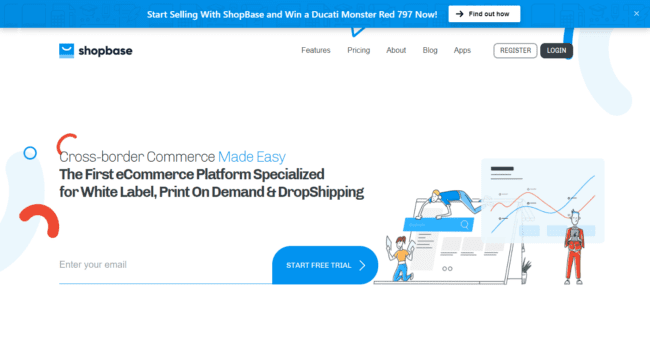
All product pages load fast, which makes it easier to speed up conversions. Every online merchant wants to get paid using the new payment gateways.
Fortunately, ShopBase is alive in the following facts.
As you set up your Print-on-demand online store, you can customize the checkout page to your preference. It helps if you are savvy in using programming languages like Javascript and CSS; you can make a few changes.
ShopBase helps merchants scale their business projections by integrating with globally accepted payment solutions.
Integrated globally accepted payment solutions give likely clients room to maneuver as they make payments for merchandise.
Attending to the logic, ShopBase has in-built functionality that allows drop shippers to make payments via:
- Stripe
- Visa
- Paypal
- Mastercard
- Bluesnap
ShopBase Winning Features.
Akin to other sales channels such as WooCommerce or even Shopify, ShopBase-loaded with tools that help build a print-on-demand online store.
ShopBase store builder offers a wide range of customizable themes, most of which are designed by highly skilled developers.
Of significance is that ShopBase has a preview mode that depicts
Precisely what you are to work with.
Every theme on its marketplace is highly optimized to spin stunning conversions. Stats show that most shoppers place orders using their mobile devices.
Because shoppers use mobile devices as the bedrock of traffic, ShopBase runs mobile-friendly software that is seamlessly accessible.
Your cart options must be a top-notch failure to which the abandoned carts will hit the roof. As a store owner of Print on Demand, I find it can be more or less disheartening.
ShopBase allows users to customize the checkout page to prevent possible mishaps with eyes on to even out the odds.
eCommerce sometimes boils down to wins and losses. Ideally, the gains ought to outweigh the latter. ShopBase provides a cart abandonment recovery solution to help.
Send out email alerts to convince visitors to complete the checkout. Furthermore, Whippy shipping rates can be set up so that a likely customer finds it convenient. And that you can opt to work with:
- Weight-based rates
- Tiered pricing
- Fixed shipping prices
- Location-based pricing
You can include a couple of related variants when you list a product virtually. This feature is beautiful because customers can shop by color, material, and size.
As a vendor, you can set multiple images and bulk import the merchandise information via CSV file. The print-on-demand system allows you to list nearly any product niche precisely.
Try the following suggestions: t-shirts, hoodies, leggings, tote bags, art prints, or even phone cases.
ShopBase does not limit its users on the number of products to upload in a rather satisfying way.
ShopBase showcases itself as a cloud-based Saas solution.
This means you get a mobile dashboard, just like Shopify. This dashboard allows you to monitor all actions in real-time from any location, provided you have a mobile device.
The merchant clicks a button to fulfill an order and contact the client, updating them on its status.
Your online store security is paramount. To alleviate those concerns, it is essential to consider ShopBase as an SSL-certified solution. It is keen enough to conduct a fraud analysis on any order.
Teespring
Teespring is a revolutionary eCommerce platform that has gained much traction over its competition. It impressively changes the way you run a print-on-demand business.

Each category leads to related listings. For instance, on Teespring, there are different kinds of socks: passion socks, love socks, cat socks, and Camo socks.
In the home décor category, a retailer can place a design order for print-on-demand for items like:
- Pillow
- Posters
- Tapestries
- Canvas prints
Mugs and accessories follow the same pattern; however, the T-shirt and sweatpants categories appear to be grabbing more attention in Print on Demand. The phone cover category is also doing pretty well.
Spreadshirt
Spreadshirt has sufficiently served POD drop shippers dating back to 2002. Spreadshirt lets you do that at low rates if you want to deal with t-shirt-creating personalized products in bulk.

Spreadshirt appears to be a directory of themed T-shirts. It uses newly developed techniques to design custom T-shirts, from funny to awareness-printed T-shirts.
Spreadshirt is a jack of all sorts of trade in the print-on-demand model.
To start selling on Spreadshirt, build an online store and list any viable and high-selling product category.
Spreadshirt’s designs in the marketplace are making it stand out. There is no need to spend sleepless nights tirelessly designing the logo; leave it to the experts.
Spreadshirt has proficient designers churning out exceptional designs that fit your needs.
Creating unique designs is one compelling factor that makes Spreadshirt a profound solution for meeting all the demands for custom-branded T-shirts.
The merchandise catalog includes women’s, kids’, and men’s clothing, as well as gifts, tank tops, Hoodies, and group wear.
Spreadshirt offers clients up to a 70 percent discount whenever they place a bulk order as part of its call-to-action technique or incentive. All orders are subject to a 30-day return policy.
Gooten
Gooten is a print-on-demand platform that leads entrepreneurs to newer heights; Gooten’s speedy integration is good riddance if you are a merchant on the Shopify platform.

Gooten, per se, can not be termed niche-focused software in the Print-on-demand business. But it has essential tools for creating designs for your product.
Gooten is a free spirit. It is a dynamic solution with a rich product listing for each product.
For instance, Gooten offers many print designs for kitchen items like mugs and aprons in its home and living categories.
You can choose exceptional product designs like pillows to decorate your living room’s accessories. A retailer can do print designs for bathroom curtains as well.
To help you save time as you push orders, Gooten cuts to the chase by listing what is in high demand in the market, like apparel—it has steadily become a top-selling category.
What is more arresting about Gooten is this white-label support. It allows a vendor to reduce the expenses of enhancing a client’s experience.
Gooten attends to all customer questions and promptly forwards all customer feedback to your inbox.
Pricing for trending products is relatively fair, allowing merchants room to adjust profit margins.
Merchify
Like other print-on-demand services, Merchify integrates with Shopify, thus automating order processing in every way.
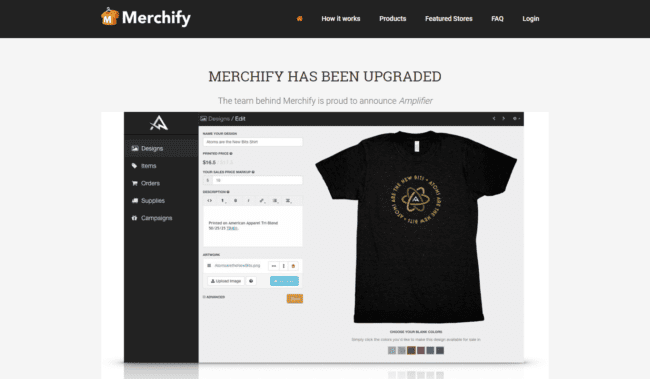
Download and install Merchify right from the Shopify apps marketplace.
Because Merchify design cuts as a print-on-demand drop shipping business, you do not need an inventory.
Owing to Shopify’s mobile-friendly responsive sales channels, a vendor can improve their conversions and merchandise search immensely.
Let’s face it. Online Shoppers can sometimes get impatient, so you have to act fast. To do that, Merchify makes it easy to boost order value through its user interface when importing product listings to your eCommerce store.
To start selling, you must first upload a product, such as a canvas or T-shirt print. Then, you import images and set keyword-tuned product descriptions, and finally, you put out your products on Shopify.
Once the customer places an order, processing starts within the next working day. Merchify handles the packing, printing, and shipping tasks, which helps a vendor cut corners and delegate the necessary priorities.
Merchify’s staff sends a tracking number as soon as a shipment is dispatched, thus easing the logistic processing. Both the customer and the merchant are keen on the order.
To help you set retail price markups, Merchify directs all the billing info to your Shopify account. You can then create all the shipping options and profit margins correspondingly. Since a client places a custom print order, Merchify notifies the same online vendor through email.
The particulars in the notifications highlight client billing info, an auto-generated order number, their shipping address, and also the description of the product bought.
A shipping authorization follows as soon as the Print on Demand is ready for dispatch. If your Shopify sanction settings are checked, Merchify instantly directs a tracking number to the client.
Print Aura
Print Aura is one of the most cost-efficient platforms that lets you design and print your custom brand. There’s a large tarn of products to select. You can either Print or buy their brand at a low rate.
The size of your store is no longer a concern. Print Aura has no restrictive minimum number of orders. Therefore, you can even print a single T-shirt without any extra commitments.
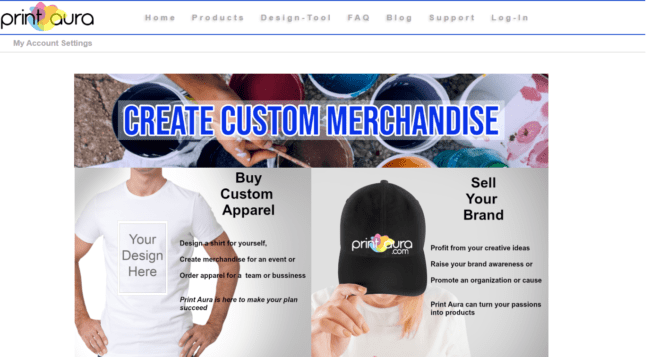
The turnaround time is also convenient for the merchant and the shopper.
Theoretically, Print Aura’s stuffers process an order within 3-5 working days. Aura’s premium version processes it in just 48 hours.
Though intensifying the production capacity might be necessary, the product quality, as anticipated by the customer, is not affected.
In short, Print Aura cuts out to scale your business to any kind that picks your objectives or goals.
Importantly, Aura has high-quality design mockups. In addition, the merchants customize the return labels and packing slips to market their brands.
It is a good sign that it provides a print guarantee for all products. The warranty covers probable and foreseeable mishaps, such as common manufacturing defects.
In addition to Shopify, Print Aura integrates with Storenvy, Etsy, Opencart, BigCommerce, and WooCommerce. All factored in. It is easy to begin the t-shirt business on Print Aura.
Above and beyond, there are more than 150k proficient designers on Print Aura to help you wade the path.
Customcat
If you are a crafty artist and you are also interested in monetizing your ideas, then Customcat is a print-on-demand tool for you.
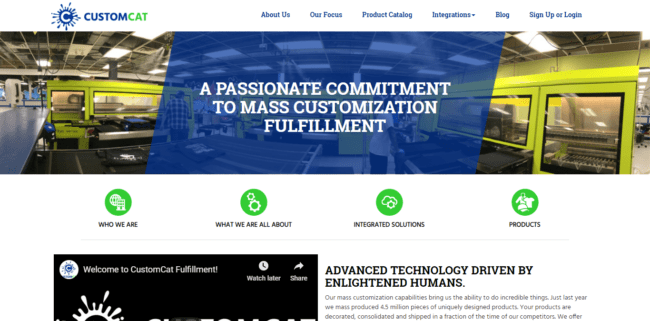
Customcat is a solution whose integration makes product imports through CSV files and links to WooCommerce or Shopify channels.
Also, Customcat is a hub for independent developers who are highly experienced with custom API.
Beyond a product printer for Sweatpants, Hoodies, t-shirts, and most others, Customcat is an enterprise-attentive solution made for industrial-identical scalability.
If a retailer sells more products, its revenues correspondingly go up. Customcat achieves this goal because it has a big warehouse to deliver mass customization orders.
Last takeaway
Is the print-on-demand eCommerce business worthwhile? You would ask. Undoubtedly, yes, it is valuable.
But here is the hack.
It works best only. Shopify, a sales channel, integrates with nearly all Print-on-demand solutions. The implicit here is that you do not need to be savvy or possess print and design skills.
However, platforms like Dribble host seasoned designers for hire at budget-friendly rates.
Another alternative approach to Print-on-demand business is to order a few samples from the supplier upon settling on a particular mockup.
POD dropshipping is an option for many because the model lets you test so many products.
Furthermore, Shopify provides optimal results for merchants selling products on demand.
Due to Shopify’s plan flexibility, it is possible to begin a business through a massive e-commerce sales channel.
Because it is a revenue-generating model like any other, you want to control your customer support apparatus.
All the print-on-demand websites in this guide are good individually; you should contemplate your needs.
What’s Print on Demand?
It’s a way to sell customized products such as t-shirts, wall art, and other items with your designs, made on a per-order basis with a printing service.
It means you don’t pay for the product until you’ve made a sale, eliminating the need to pay upfront, buy in bulk, or hold any inventory.
Like dropshipping, this drastically reduces the barrier to entry into e-commerce and frees up funds to allocate to marketing strategies.
When using Print on Demand, a printing partner handles everything after the sale, from printing to packing and shipping.
Your profit is the difference between selling your product minus the product’s cost from your supplier.
So, if you sell a T-shirt for $25 and your supplier charges you $7.50 for the product + printing and packaging, your profit is $17.50.
Let’s dig deep into this Print On-demand Course and learn what many would charge you to know.
Who Is Print on Demand for
It doesn’t matter if you’re entirely new to e-commerce or not tech-savvy; it’s a great business model for introducing yourself to the world of e-commerce.
If you’re already an influencer or musician, this is an excellent, low-risk business model for adding an extra revenue stream to your existing operation.
With Print-on-demand, you can easily create an online merch store and sell custom-branded products to your existing fans and followers.
It wouldn’t make sense not to define POD in this print-on-demand course; hence, there is a need.
Types of Print on demand Products To Sell
Many options exist for creating products, and new products are continually added. The type of product to sell matters, so this topic plays a significant role in this Print-on-Demand Course.
We must find your Print-on-demand niche before anything else.
Traditionally, you see many people creating custom t-shirts and wall art, but there are many more products you can print on. You can create custom (takes a deep breath):
- Mugs
- Sweatshirts
- Hats
- Pillows
- Shower curtains
- Jackets
- Leggings
- Skirts
- Swimwear
- Dresses
- Backpacks, tote bags, fanny packs
- Flip flops
- Laptop and Phone cases
- Socks
- Stickers
- Aprons
- Beach towels
- Bean bag chairs
- Jewelry
- Canvas shoes
- And even puzzles
Open and set up your store overview.
- Sign up for Shopify
- Choose a theme
- Choose a print-on-demand partner
- Set up payments and shipping
Sign up for Shopify
The first and most important thing you should do, as suggested in this Print On-demand Course, is to create a website.
Once your Shopify store is created, log into the Shopify admin panel.
Shopify offers three free trials to help you design the store, research the product, and customize it before launch.
Start a free 3 Day trial and enjoy 3 months of Shopify for $1/month Instead of $39/month on selected plans. Sign up now
With the Shopify 3 days free trial, your shop won’t be live, and customers won’t be able to see your homepage or live URL of your store unless you choose one of the Shopify pricing packages, which are:
The admin page is where you manage everything that has to do with your store.
Here you can:
- Add products
- Fulfill orders
- See your sales for the day
- Configure your storefront
- Add sales channels
- And a whole lot more
This training aims to get you to your first sale quickly, so I won’t show you everything you can do with the Shopify store. Instead, I’ll focus on the fundamental essentials.
Join the Print-on-demand Webinar and learn more! CLICK HERE
In the future, you can explore everything else on your own.
Choosing a Shopify theme
The Shopify App Store has many beautiful themes to get your store started.
Boost your ecommerce sales with Debutify Theme – the AI-powered, user-friendly, and stunningly designed shopify theme with advanced customizations, all without needing any code.

You can preview your store’s current appearance by clicking the “eye” icon next to “Online Store” under your “Sales Channels.”
I recommend Turbo Portland by Out of the Sandbox Shopify theme.
Most of the installations followed by the newest kid on the blog, the Debutfy theme, are taking over the e-commerce world, with 150,000 Installations a few months after launch.
How to find a new Shopify theme for your Print-on-demand store.
- Click “Online Store” under “Sales Channels.”
- And under Themes
- Theme Library
- Visit the theme store to explore Shopify themes.
Since this is your first store, you might as well explore Shopify’s nine free themes.
Click “All themes” on the top bar and tick off “Free” to explore the free themes.
With all Shopify themes, you can preview a demo of the theme and see what it looks like on Desktop and Mobile.
Click the “Add theme” button and let the theme install. Great. The theme has been added to your store but has not yet been published.
- Scroll down and click “Actions.”
- Click “Publish” and
- Click “Publish” again.
Your theme has been installed and published in your store.
Print-on-demand partner
Now that our store is created with a great-looking theme, you need to choose a print-on-demand partner and integrate them with your store.
The great thing about doing Print-on-demand with Shopify is that so many great print-demand partners integrate seamlessly with Shopify.
Head to your Shopify Print-on-demand dashboard and click “Apps” in the left toolbar.
It is where Somebody will locate all the apps you’ve installed in your one product store.
- Click the “Visit the Shopify App Store” button.
- Click on “Categories” and “Finding products.”
- Click “Print on demand.”
Most of them choose from, and making a decision can be overwhelming, so let’s walk through what to think about before deciding on a print-on-demand partner.
A few important things to consider when you’re choosing a print-on-demand partner are:
- What products interest you?
- If you want to sell t-shirts, every print-on-demand supplier has them available, but you should consider what type of t-shirts you want to sell.
- Do you want your t-shirts to be American Apparel, Champion, or Gildan?
- Do you want a T-shirt with a specific weight, a style like a V-neck or a tank top, or a partner that offers all-over T-shirt printing?
If you want to sell more specialized products like Print-on-demand shoes, you might want to check out Pillow Profits Fulfillment.
Maybe you want to sell Puzzles; in that case, you want to check Subliminator.
Other factors to consider when choosing a print-on-demand partner include product prices and any applicable service and production fees.
Some print-on-demand partners allow you to print designs on a T-shirt in multiple locations, for example.
You can print on the T-shirt’s front, back, and inside, where the tag would be, on sleeves, and other areas.
Each supplier will incur different costs for those additional design placements.
Lastly, you’ll want to consider the location or locations of your supplier’s facilities.
Maybe you want only to serve customers in the United States, so it would make sense for your supplier to have a facility in the States to reduce shipping costs and fulfillment time instead of being in Europe.
This article will use Printful as our Print-on-demand supplier.
Printful already has the highest reviews and installation on the app store.
Click “Add app,” then click the “Install app” button in the bottom right.
For this supplier, you’ll need to create an account with Printful.
Click the “Connect Store” button, and we will have Printful integrated with our Shopify store.
Create your first Print-on-demand design.
We’ll return to Printful in a bit, but first, in this Print-on-Demand Course, let’s discuss creating designs for your print-on-demand products.
This part is fun, and you can let your creativity shine.
Now, you don’t have to be a designer for this part.
I will provide three ways to get awesome designs to start selling your products.
Create it yourself
Create it yourself. If you are a designer, you can, of course, create your print-on-demand store designs yourself.
It is the ideal or excellent option for someone looking to throw something up and quickly run a test.
You can use any program to create your designs; remember that each supplier may require specific image dimensions and formats.
Be sure to look at these requirements yourself before you start designing.
As a general rule of thumb, you should save your file as a PSD or transparent PNG.
As I said, dimensions will vary depending on the supplier and your printing products.
The image dimensions for a mug versus a t-shirt will differ, as t-shirts are larger than mugs.
With any design, regardless of size, you’ll want the highest resolution possible. However, always refer to your supplier’s product requirements.
Photoshop or Illustrator is the most advisable programs for designing graphics, but some free alternatives are
- Photopea.com
- Pixlr.com
- Canva.com
Hire someone
Hire someone. The alternative to creating your design is to hire someone to do this all for you.
The cost of hiring a well-experienced freelancer will vary depending on where you go, but the quality will change, too, depending on how much you’re willing to pay.
You can find freelancers on websites such as Upwork or Fiverr, or you can go to websites where artists publish their work and portfolio to see designs similar to the look you’re going for.
Just contact them and check if they are interested in working with you. Behance, Dribble, and DeviantArt are great artist portfolio websites.
You can also find artists on Instagram by searching hashtags related to graphic designers, such as #GraphicDesigner, #FreelanceDesigner, #GraphicArtist, and more.
When you search for a trending hashtag, you can also explore the related hashtags to find more examples and designers.
Buy design templates
The last option for getting your designs is to buy a template. A few websites offer design templates that you can use and sell on your products.
It might be the most affordable option, but it may not be ideal since, technically, anyone can sell the same designs as you.
Sites like Designious and T-Shirt Factory specialize in selling T-shirt designs for between $7 and $25.
Creative Market and GraphicRiver, on the other hand, sell various graphic assets and templates for use on various products.
Create a product mockup.
Once you have your design file, you can create a product mockup.
A product mockup will allow us to create lovely product photos without taking a picture of our product ourselves.
Mockups are a realistic representation of your design that you can use in your ad creative, store, and product pages.
The first way to create a mockup is to use a free mockup generator. Printful and many other Print Demand partners offer free mockup generators, which we’ll be using.
Alternatively, websites like Creative Market and GraphicRiver sell mockup templates for all products in different styles and formats.
There are mockups of models, lifestyle shots, and the product itself. Depending on your needs, mockup templates will cost anywhere from $9 to $40.
These paid alternatives offer more flexibility if you’re willing to spend money and look for something specific.
Adding your first product to your store
Now that we have a design, let’s add our first product to our store. Depending on your print-on-demand supplier, there are a few ways to do this.
- Click “Apps” and then the Printful app.
- Click “Products” on the top bar,
- Scroll down and click “Add product.”
These are not required before launching your store, but I highly recommend doing them.
Product pages help you sell your product, but you need several other pages on your store to tell your story and market your brand – this will help establish trust with your customers.
Before launching, you should have a few standard pages ready to go:
These pages include:
- An About Us page
- A contact page
- A privacy policy and terms of service which you can generate within Shopify
- A refund policy
- A Shipping policy
- An FAQ page addresses common questions and concerns your customers might have.
Payments
Okay, now let’s set up our payments. It will allow you to accept credit cards and PayPal in our store and enable you to get paid!
Under “Settings,”
“Click on Payments.”
Here, we can set up Shopify payments, change payment providers, and add payment providers.
I recommend Shopify Payments as your store’s primary payment gateway.
This will allow you to accept major credit cards like Visa and Mastercard. Alternatively, you can use PayPal or both Shopify Payments and Paypal on your store to get customer orders.
Suppose Shopify payments are not accepted in your region, or you want to use another payment gateway to accept credit card payments.
In that case, you can click “Change provider” and select from a list of popular payment gateways to integrate with your Shopify store.
- We’re going to use Shopify payments.
- Click complete account setup to get started.
- You’ll then be asked to enter your business details.
If you’re unsure or haven’t registered a business yet, I recommend setting up as an Individual.
You’ll also be asked to provide banking information so Shopify can pay you.
Follow the steps, fill out the forms, and your store will be ready to accept credit cards.
You can also register as a UK Company for non-residents, which will allow you to have a UK Stripe account or UK PayPal and a UK business account on Transfwerwise, which comes with a debit card; hence, you can operate your dropshipping business or print-on-demand store with no payment limitations or bans.
Get UK Company registered as a non-resident. Click HERE.
Shipping
Next, let’s set up shipping.
Here’s where we can set our customers’ shipping rates and methods.
Again, click “Settings” and then “Shipping.”
You can set shipping rates for your store, fix different shipping rates for other countries, and choose how shipping is calculated at checkout.
Our choices are calculating shipping rates for our customers by weight, price, and region or calculating them at checkout using an app or API from a shipping provider.
You can also skip this section and let an app such as Printful override these shipping settings.
We can also set flat rates for shipping here or make shipping accessible. I like keeping things simple, so I will make shipping accessible in our store and solely factor that into the cost of our products.
To set Free Shipping on all orders in your store, you should first Delete the default Shipping zone Shopify that was already set up for you and leave the “Rest of world” shipping zone.
Studies have shown that consumers are more receptive to free shipping, so we might see more conversions and purchases since we can now advertise “Free Shipping” across our store.
Remember that shipping prices will vary in different countries.
Instead, you may want to offer Free Shipping to the US and a flat rate for the Rest of the World. This will depend on the items you’re selling and the print-on-demand supplier you’re using.
Settings
Next, you’ll want to go through all the settings on your Shopify store.
There might be a setting you never knew existed or an option you might want to change that you never knew you could.
Whenever I learn a new Software or platform, I know how to use it the fastest by merely playing around with it.
One thing I always do is look at every single option available.
You should do this with Shopify, too, especially if it feels overwhelming to you right now.
Password page
One last thing we need to do to launch our store is make your store live!
If we visit our myshopify.com store URL, we’ll notice a password page protecting our store while creating it.
Head over to “Online Store” in our dashboard and click “Preferences,” and you’ll see our Password page options.
To make our store live, we’ll need to click “Disable password.” Once we do that, our store is accessible to anyone who visits it.
Getting your first sale
Congratulations! If you follow along, your store is live and ready to accept orders! Now, let’s focus on getting you some customers!
Here are some things that won’t help you get your first sale:
- Perfecting your website won’t get you your first sale – make it good enough and move on
- Optimizing your website won’t get you your first sale
- And Spending days thinking up a logo or branding won’t get you your first sale
Here’s what will help you get your first sale.
- Focus on easy-to-try marketing channels that provide immediate results
- Play with free methods and work with paid ways of getting traffic
- Focus on one marketing channel
- And learn as much as possible
Where will you get traffic for your Print-on-demand store?
Okay, now that we know what will help us get our first sale and what won’t, we need to figure out where to promote our products and find our customers.
Here’s a list of all the standard ways business owners drive traffic to their stores.
These aren’t all the ways and places, but they’re an excellent start. Focusing on just one of these traffic sources is often enough to make it work.
So, where can you get traffic from?
First, we can use paid advertising from platforms like:
- Instagram, which Facebook owns
- Google Ads, which includes Search ads, Display ads, Shopping ads, and YouTube ads.
Personally, when it comes to paid advertising, Facebook is the platform I’d start with.
You can get started for as little as $5 a day, and their targeting options allow you to set up highly effective campaigns designed to reach your ideal customer.
They also provide you with fast results, meaning, within a few minutes of someone purchasing your product from a Facebook ad, you can see precisely what ad provided the results.
There are many great online resources for getting started with Facebook ads, including Shopify Compass, which offers free online courses covering multiple topics.
Influencer marketing.
If you’re unfamiliar with the term, influencer marketing is a marketing method that taps into a person of influence who has a following of people who respect and trust what they say.
It’s like when a good friend recommends a new movie or piece of music to watch; because you value their opinion and taste in film and music, you are much more likely to take their recommendation.
Influencers come in all forms, and you can find them almost everywhere.
Places to start looking for influencers can be:
- Youtube
- Blogs
- Twitch
- Tiktok
Influencers also come in all sizes, from micro-influencers with a few hundred or a few thousand followers to massive influencers with millions and millions of followers.
Usually, you pay an influencer a set fee to post your product to their following for a set amount of time.
Affiliate marketing.
Affiliate marketing is a reward-based system that encourages partners to promote your Print-on-demand products in exchange for a commission.
You can pay affiliate marketers a set fee for every sale they make or a percentage of each sale they get you. What’s great about affiliate marketing is you only pay your affiliate after they make you a deal.
There are many great affiliate sites, such as Share-a-sale, on which you can post your offer or create your affiliate program. Content marketing is another traffic source you can tackle.
Content marketing
Content marketing mainly creates and distributes valuable, relevant, consistent content to attract new customers.
These can include:
- Posting blog articles on your website that relate to your business or product.
- You can design infographics and post them on Pinterest.
- Creating videos for your YouTube channel.
- Posting consistently on your Instagram and Facebook pages.
- Or Start your podcast geared towards your target market.
Although content marketing might not initially drive a large amount of traffic and sales, it helps support your other marketing efforts, and creating the content is a lot of fun.
Lastly, you can engage with existing communities across multiple platforms.
Places like:
- Facebook groups
- Online forums
- Quora
- Medium
Contributing to places like these can help build authority within your niche and make people see you as an expert and a trustworthy brand. Learning something in this Print On-demand Course?
Keys to Success
As you begin your journey, focus on these things to set yourself up for success.
Focus on things that drive traffic and sales and invest in long-term marketing efforts.
Don’t set your profit margins too low so you have room for advertising costs.
Don’t expect quick results – learning what designs and products your niche will love will take some time.
During your trial, you can apply everything you learned today to:
- Set up and launch your store
- Find and add products
- And work on getting your first sale.
Summary
As always, introducing printing on-demand with Shopify was a great pleasure.
I hope this guide helped you find a Print-on-Demand Course to help you start a print-on-demand business.
Print-on-demand services provide an accessible inventory source for new entrepreneurs or anyone who wants to test an idea before investing in it.
Suppose one of your ideas emerges, and you start generating significant sales.
In that case, you can always graduate from using the on-demand print site to hold your inventory or continue to use these services while finding new ways to increase your audience.
Yours is the choice. I wish you all the best on your journey and hope to see you soon!
Start Shopify For Only
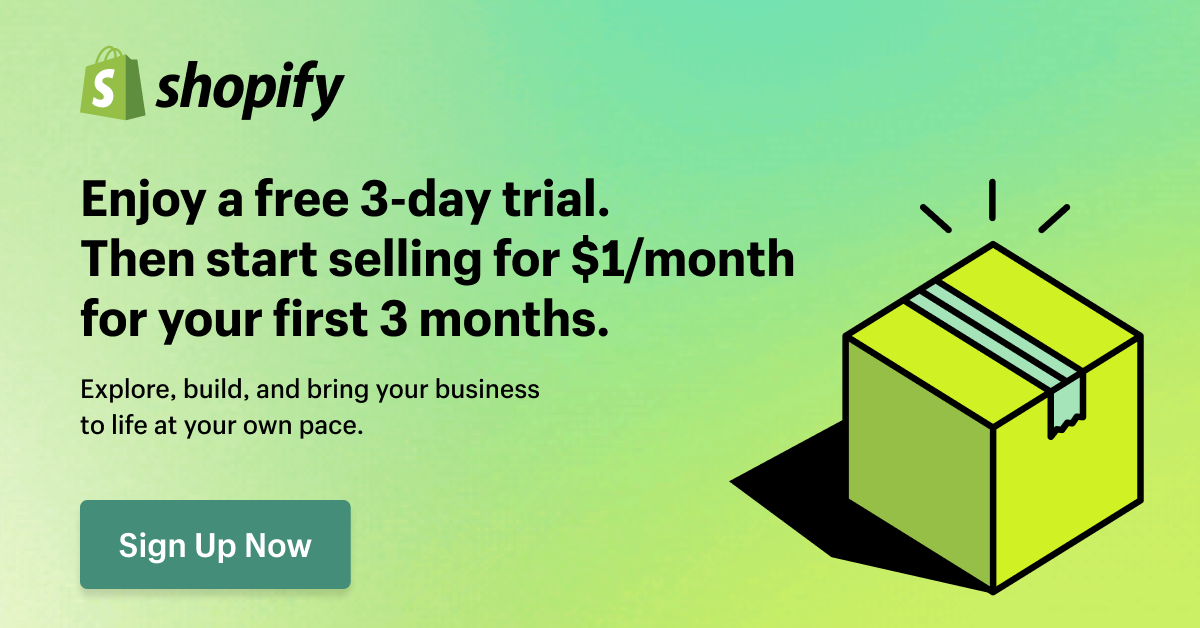
Try Shopify free for 3 days, no credit card is required. By entering your email, you agree to receive marketing emails from Shopify.

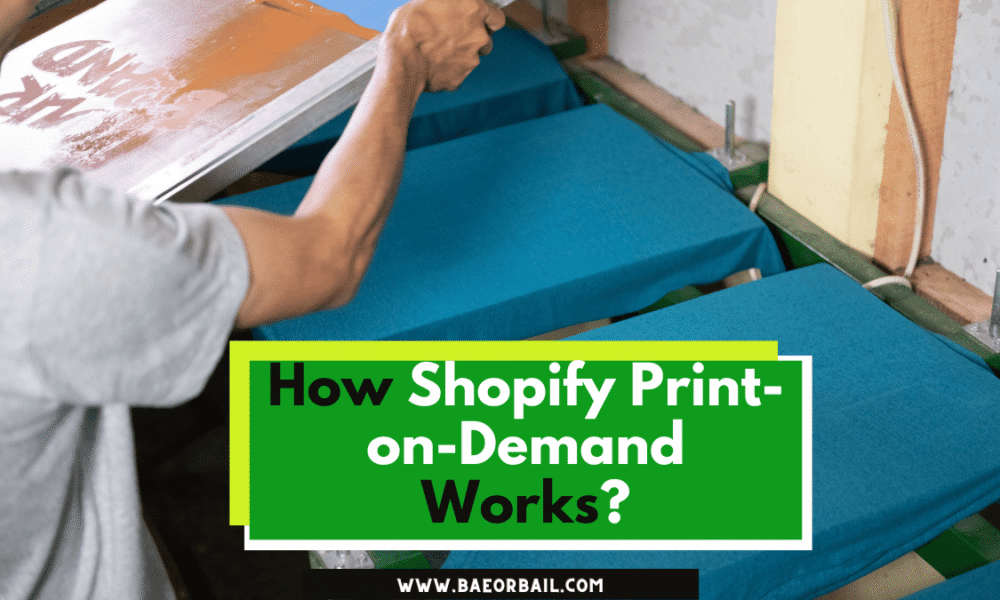
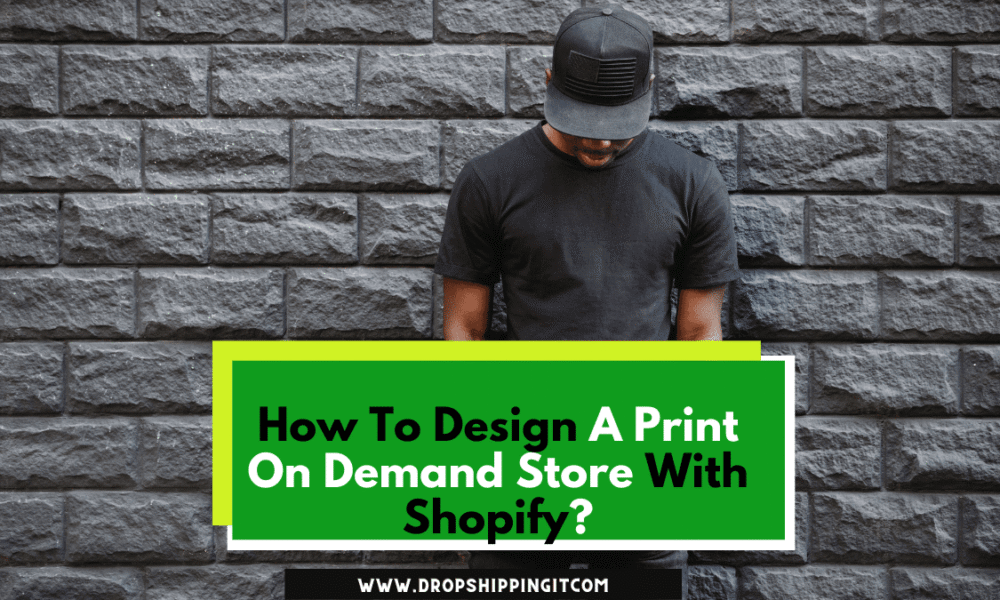
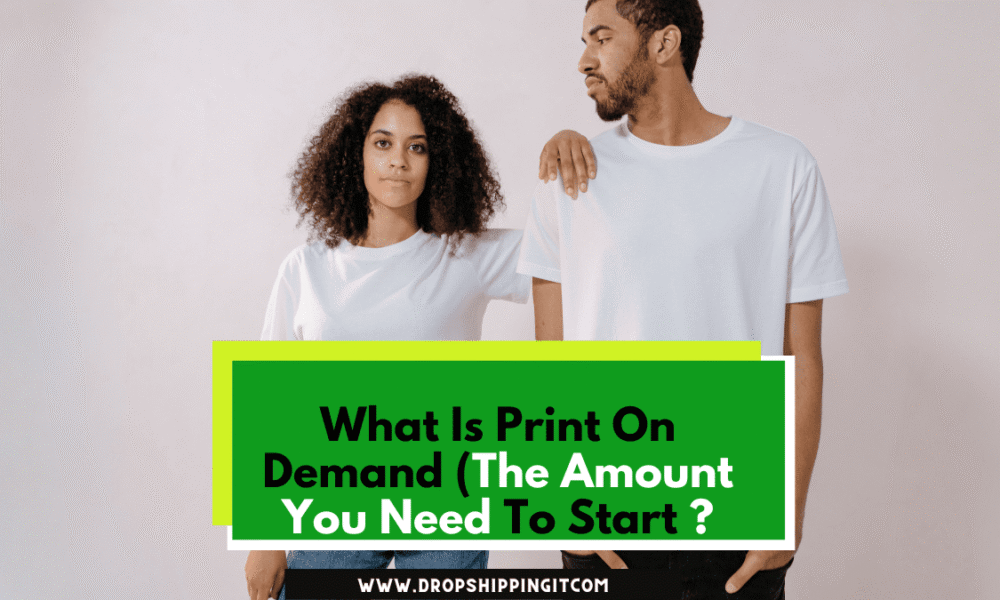
Comments (0)